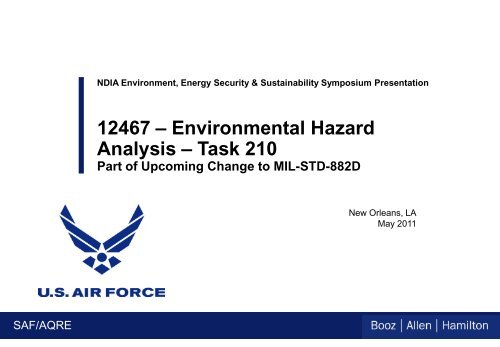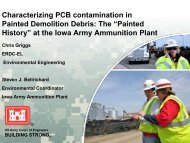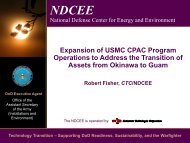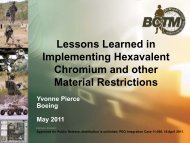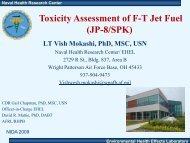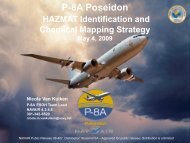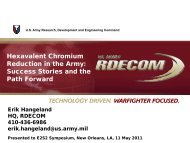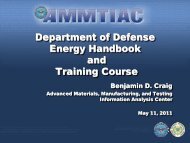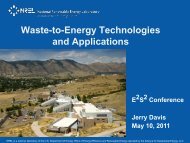12467 â Environmental Hazard Analysis â Task 210 - E2S2
12467 â Environmental Hazard Analysis â Task 210 - E2S2
12467 â Environmental Hazard Analysis â Task 210 - E2S2
Create successful ePaper yourself
Turn your PDF publications into a flip-book with our unique Google optimized e-Paper software.
NDIA Environment, Energy Security & Sustainability Symposium Presentation<br />
<strong>12467</strong> – <strong>Environmental</strong> <strong>Hazard</strong><br />
<strong>Analysis</strong> – <strong>Task</strong> <strong>210</strong><br />
Part of Upcoming Change to MIL-STD-882D<br />
New Orleans, LA<br />
May 2011<br />
SAF/AQRE
1<br />
Bottom Line Up Front<br />
MIL-STD 882 is the DoD Standard Practice for System Safety<br />
DoDI 5000.02 requires programs to use MIL-STD 882 system<br />
safety process to integrate ESOH considerations into Systems<br />
Engineering<br />
When issued, the new MIL-STD-882E will include task<br />
descriptions that can be placed on contract with the Original<br />
Equipment Manufacturer/Prime Contractor<br />
<strong>Task</strong> <strong>210</strong> describes how the contractor should use the<br />
MIL-STD 882E system safety risk management process for<br />
<strong>Environmental</strong> <strong>Hazard</strong> <strong>Analysis</strong><br />
SAF/AQRE
2<br />
Overview<br />
Introduction<br />
Background<br />
– MIL-STD 882 System Safety Process<br />
– Risk Assessment Matrix<br />
– Severity<br />
– Probability<br />
<strong>Task</strong> <strong>210</strong><br />
– Purpose and Structure<br />
– Example <strong>Hazard</strong><br />
Risk Acceptance<br />
SAF/AQRE
3<br />
Introduction - Defense Acquisition Management System<br />
User Needs<br />
Strategic<br />
Guidance<br />
Joint<br />
Concepts<br />
Capabilities - Based<br />
Assessment<br />
ICD<br />
MDD<br />
Materiel<br />
Solution<br />
<strong>Analysis</strong><br />
A<br />
Technology<br />
Development<br />
B<br />
CDD<br />
Engineering & Manuf<br />
Development<br />
C<br />
CPD<br />
Operations & Support<br />
Production &<br />
Deployment<br />
O&S<br />
OSD/JCS COCOM<br />
FCB<br />
Incremental Development<br />
JCIDS Process<br />
Acquisition Process<br />
SAF/AQRE
4<br />
Introduction - DoD 5000.02 Acquisition ESOH Policy<br />
Use MIL-STD-882D, DoD Standard Practice for System Safety<br />
– In all developmental and sustaining engineering activities<br />
– To manage ESOH risks as part of the systems engineering<br />
process<br />
– Across the Acquisition Life cycle<br />
ESOH refers to all individual, but interrelated, disciplines that<br />
encompass environment, safety, and occupational health<br />
SAF/AQRE
5<br />
Background - MIL-STD-882D System Safety Process<br />
1. Document the system safety approach<br />
2. Identify hazards<br />
3. Assess risk<br />
4. Identify mitigation measures<br />
5. Reduce risk<br />
6. Verify risk reduction<br />
7. Accept risk<br />
SYSTEM SAFETY ORDER OF PRECIDENCE<br />
1. Eliminate hazards through design selection<br />
2. Reduce risk through design alteration<br />
3. Incorporate engineered features or devices<br />
4. Provide warning devices<br />
5. Develop procedures and training<br />
8. Manage life-cycle risk<br />
Risk = Severity x Probability<br />
SAF/AQRE
6<br />
Background - The Risk Assessment Matrix<br />
SAF/AQRE
7<br />
Background - ESOH Risk: Severity<br />
Mishap. An unplanned event or series of<br />
events resulting in death, injury,<br />
occupational illness, damage to or loss of<br />
equipment or property, or damage to the<br />
environment. For the purposes of this<br />
document, the term “mishap” includes<br />
negative environmental impacts from<br />
planned and unplanned events and<br />
accidents<br />
Severity generally does not change<br />
unless an engineering design change is<br />
made<br />
SAF/AQRE
8<br />
Background - ESOH Risk: Probability<br />
SAF/AQRE
9<br />
Background - Revision of MIL-STD 882D Underway<br />
882 already provides a methodology for risk management<br />
Revising MIL-STD-882D to be better suited for Managing <strong>Environmental</strong> Issues as part of the<br />
Systems Engineering Process<br />
<strong>Task</strong>s are being added to address environmental considerations<br />
<strong>Task</strong> 105 – <strong>Hazard</strong> Tracking System<br />
<strong>Task</strong> 107 – <strong>Hazard</strong>ous Materials Management Plan (HMMP)<br />
<strong>Task</strong> <strong>210</strong> – <strong>Environmental</strong> <strong>Hazard</strong> <strong>Analysis</strong><br />
Making MIL-STD 882 more “User Friendly”<br />
for <strong>Environmental</strong> Professionals<br />
SAF/AQRE
10<br />
<strong>Task</strong> <strong>210</strong> – Purpose and Structure<br />
Purpose: Use System Safety process to identify environmental hazards, assess the<br />
associated risk, identify potential mitigation measures, implement chosen measures, reassess<br />
the risk, and obtain formal risk acceptance<br />
<strong>Task</strong> Structure:<br />
<strong>210</strong>.1 Purpose<br />
<strong>210</strong>.2 <strong>Task</strong> Description<br />
• Using system safety process and risk matrix<br />
• Identifying <strong>Environmental</strong> Requirements and <strong>Hazard</strong>s<br />
• <strong>Environmental</strong> analysis considerations<br />
• Reporting Requirements<br />
<strong>210</strong>.3 Details to be Specified<br />
• Added by Government to Contract Scope to Bound the <strong>Analysis</strong><br />
SAF/AQRE
11<br />
<strong>Task</strong> <strong>210</strong> – Example <strong>Hazard</strong><br />
Example – Contaminated Wash Water from Nickel-Cadmium Plated Compressor Blades on T-56 Turboprop Engine<br />
<strong>Hazard</strong><br />
Description<br />
Initial<br />
Severity<br />
Initial<br />
Prob.<br />
Initial Risk<br />
Category<br />
Risk Mitigation<br />
Target<br />
Severity<br />
Target<br />
Prob.<br />
Target<br />
Risk<br />
Category<br />
Status<br />
Contaminated<br />
wash water from<br />
Ni-Cd Plated<br />
Compressor Blades<br />
Cadmium<br />
contaminated<br />
wash water<br />
effluent a NPS<br />
water pollutant in<br />
violation of State<br />
law (regulation of<br />
storm water<br />
discharge/NPDE<br />
S) with potential<br />
for citations with<br />
fines, and civil<br />
and/or criminal<br />
liability for<br />
improper disposal<br />
of hazardous<br />
waste.<br />
Cadmium<br />
contaminated<br />
drinking water<br />
can result in<br />
acute and chronic<br />
health efforts.<br />
2<br />
2<br />
B<br />
B<br />
High<br />
High<br />
100 percent capture<br />
mandate for engine<br />
wash water requiring<br />
all DoD facilities to<br />
capture, contain, and<br />
properly treat or<br />
dispose of wash<br />
water effluent.<br />
Develop new<br />
compressor blades<br />
made of aluminum to<br />
replace the Ni-Cd<br />
plated blades. New<br />
blade design will<br />
eliminate the<br />
possibility of Cd<br />
leaching into the<br />
wash water effluent<br />
by eliminating the use<br />
of a hazardous<br />
material.<br />
3<br />
None<br />
C<br />
None<br />
Med<br />
None<br />
This Program implemented this risk<br />
mitigation measure, verified its<br />
effectiveness in reducing the risk,<br />
and the PM accepted the FRC.<br />
However, the PM directed that during<br />
subsequent rework/upgrade of the T-<br />
56 turboprop engine an alternative<br />
risk mitigation measure must<br />
eliminate the hazard.<br />
The Program verified that new Al<br />
blade design eliminated the hazard.<br />
Thus, the PM had no risk to accept.<br />
SAF/AQRE
12<br />
<strong>Task</strong> <strong>210</strong> – Example: <strong>Hazard</strong> Description<br />
<strong>Hazard</strong><br />
Contaminated<br />
wash water from<br />
Ni-Cd Plated<br />
Compressor<br />
Blades<br />
Description<br />
Cadmium contaminated wash water effluent a NPS<br />
water pollutant in violation of State law (regulation<br />
of storm water discharge/NPDES) with potential for<br />
citations with fines, and civil and/or criminal liability<br />
for improper disposal of hazardous waste.<br />
Cadmium contaminated drinking water can result in<br />
acute and chronic health efforts.<br />
SAF/AQRE
13<br />
<strong>Task</strong> <strong>210</strong> – Example: Initial Risk Assessment<br />
Initial<br />
Severity<br />
Initial<br />
Probability<br />
Initial Risk<br />
Category<br />
2 B High<br />
SAF/AQRE
14<br />
<strong>Task</strong> <strong>210</strong> – Example: What is the Severity?<br />
SAF/AQRE
15<br />
<strong>Task</strong> <strong>210</strong> – Example: What is the Probability?<br />
SAF/AQRE
16<br />
<strong>Task</strong> <strong>210</strong> – Example: Mitigations and Target Risk #1<br />
Risk Mitigation<br />
Target<br />
Severity<br />
Target<br />
Probability<br />
Target Risk<br />
Category<br />
Status<br />
100 percent capture<br />
mandated for<br />
engine wash water<br />
requiring all DoD<br />
facilities to capture,<br />
contain, and<br />
properly treat or<br />
dispose of wash<br />
water effluent.<br />
3 C Med This Program implemented<br />
this risk mitigation measure,<br />
verified its effectiveness in<br />
reducing the risk, and the<br />
PM accepted the Final Risk<br />
Category (FRC).<br />
However, the PM directed<br />
that during subsequent<br />
rework/upgrade of the T-56<br />
turboprop engine an<br />
alternative risk mitigation<br />
measure must eliminate the<br />
hazard.<br />
SAF/AQRE
17<br />
<strong>Task</strong> <strong>210</strong> – Example: Mitigations and Target Risk #2<br />
(Program Manager’s Preference)<br />
Risk Mitigation<br />
Target<br />
Severity<br />
Target<br />
Probability<br />
Target Risk<br />
Category<br />
Status<br />
Develop new<br />
compressor blades<br />
made of aluminum to<br />
replace the Ni-Cd<br />
plated blades. New<br />
blade design will<br />
eliminate the<br />
possibility of Cd<br />
leaching into the wash<br />
water effluent by<br />
eliminating the use of<br />
a hazardous material.<br />
None F Eliminated The Program verified that new Al<br />
blade design eliminated the<br />
hazard. Thus, the PM had no<br />
risk to accept.<br />
SAF/AQRE
18<br />
<strong>Task</strong> <strong>210</strong> – Example: Assessed Risk<br />
Initial Risk<br />
Target Risk #1<br />
Target Risk #2<br />
SAF/AQRE
19<br />
Risk Acceptance<br />
ESOH Risk must be accepted prior to exposing people,<br />
equipment, or the environment to the hazard<br />
– All the mitigations must be verified effective and the<br />
associated risk is accepted (by appropriate authority)<br />
SAF/AQRE
20<br />
Questions<br />
Government Client<br />
– Sherman G. Forbes<br />
– SAF/AQRE<br />
– Acquisition ESOH Risk Management<br />
– Phone: 703-254-2480<br />
– E-mail: sherman.forbes@us.af.mil<br />
Presenter<br />
– William A Thacker Jr<br />
– Booz Allen Hamilton<br />
– Phone: (703) 412-7757<br />
– E-Mail: thacker_william@bah.com<br />
SAF/AQRE
21<br />
BACK UP CHARTS<br />
SAF/AQRE
22<br />
Background<br />
System environmental risks could result in mission and operational constraints and compliance<br />
burdens for receiving installations, training ranges, and operational units<br />
Influencing design decisions is typically the most cost-effective means of effecting change to<br />
a system<br />
– It is important to consider potential environmental impacts during system design to eliminate<br />
the hazard vice manage them as operational constraints<br />
Restricted times / intervals of operation<br />
Restrictions on locations of operation<br />
Negative impact of the environment<br />
Fines and costs to manage/mitigate impacts<br />
SAF/AQRE
23<br />
Background<br />
Early identification and resolution of environmental hazards through the systems engineering<br />
process<br />
– Bring environmentally-driven requirements to the table early in the process<br />
– Provides decision makers with a more complete and relevant picture of the potential risks<br />
associated with test, operation, sustainment, and disposal of the system<br />
Advocate for funds for design changes or plan for operational<br />
mitigations<br />
– Helps mitigate the risk of unplanned technical, schedule, and cost impacts<br />
SAF/AQRE
24<br />
DoD Standard Practice for System Safety<br />
SAF/AQRE


